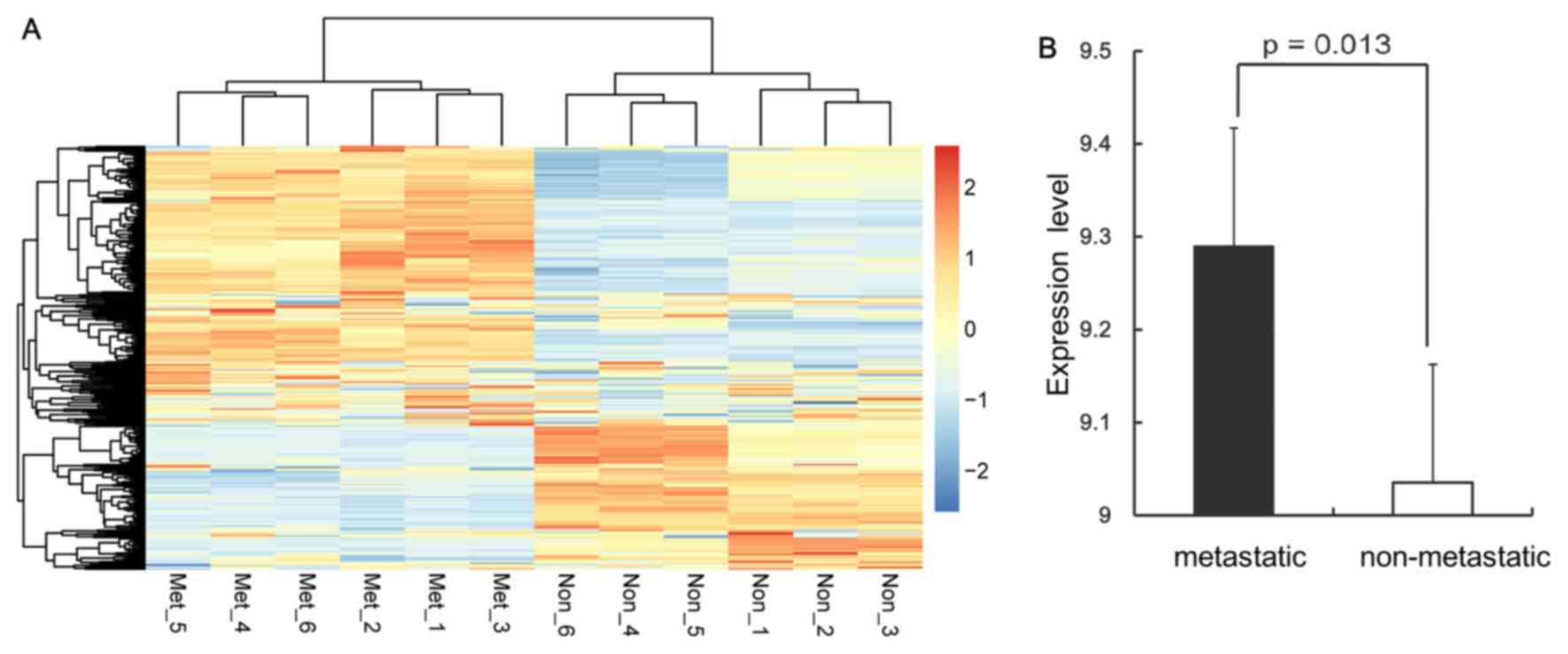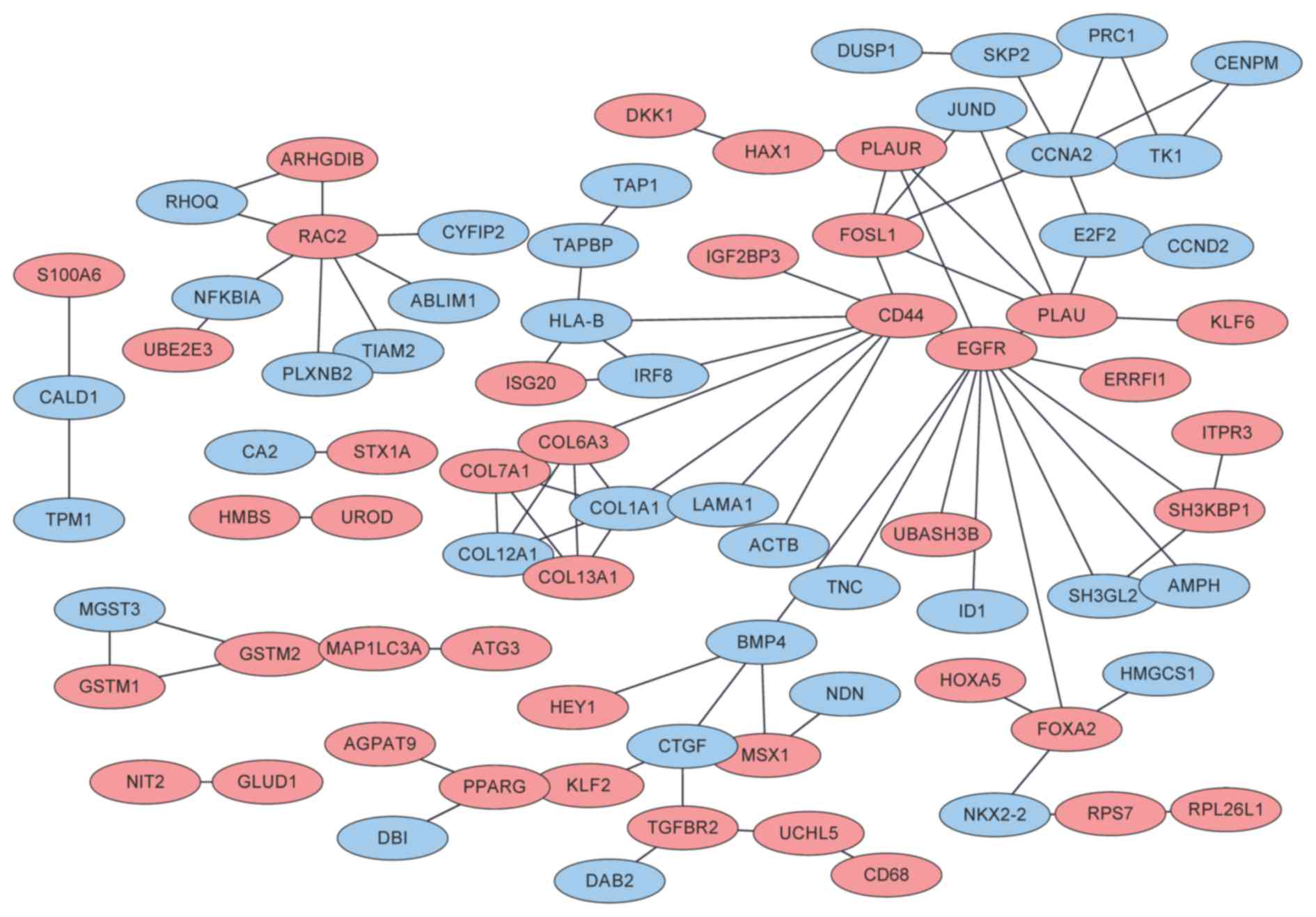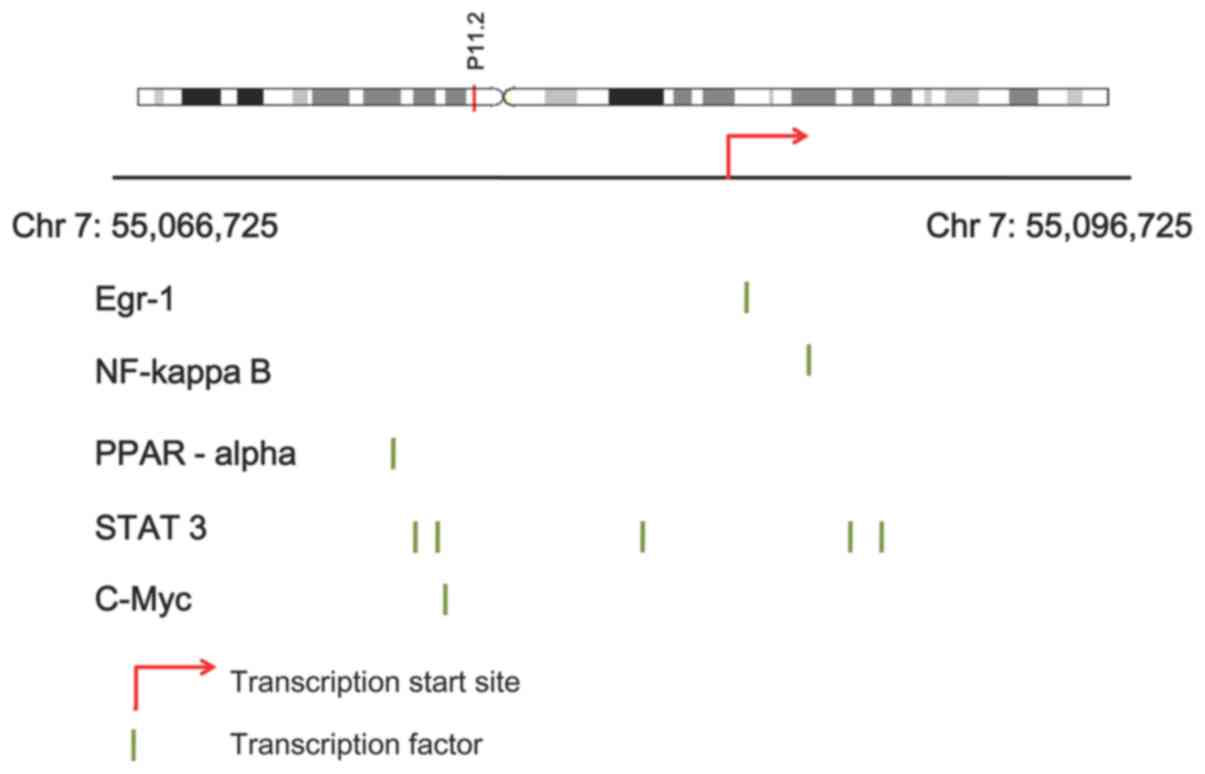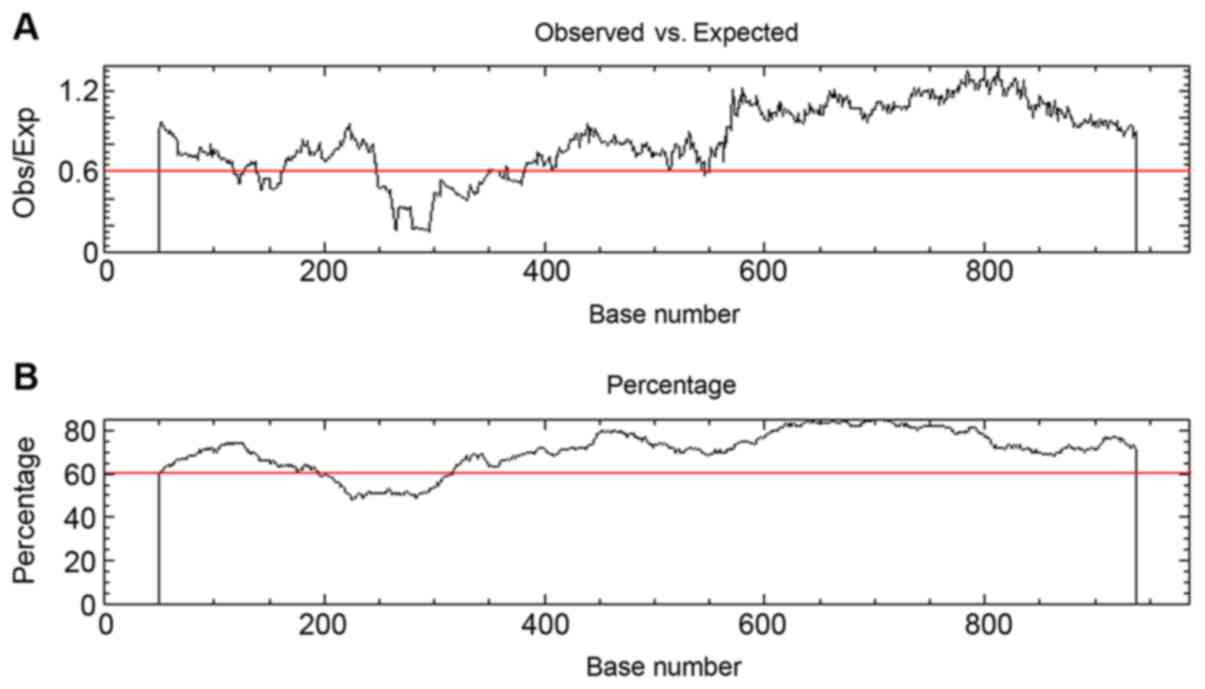Identification and analysis of key genes in osteosarcoma using bioinformatics
- Authors:
- Published online on: December 19, 2017 https://doi.org/10.3892/ol.2017.7649
- Pages: 2789-2794
-
Copyright: © Diao et al. This is an open access article distributed under the terms of Creative Commons Attribution License.
Abstract
Introduction
Osteosarcoma (OS) is an invasive malignant neoplasm of the bones that originates from primitive transformed cells (1). OS is often derived from the metaphyseal region of tubular long bones, with 10, 19, and 42% of OS cases occurring in the humerus, tibia, and femur, respectively (2). OS is the most common type of bone cancer among children and teenagers (3). In pediatric patients, OS ranks eighth among all types of cancer incidence, accounting for ~20% of all primary bone cancers and 2.4% of all malignant tumors (4). Therefore, assessing the key genes associated with OS is crucial.
The downregulation of naked cuticle homolog 2 and alterations in its associated signaling pathways contribute to tumor growth and metastasis in patients with OS (5). Ribophorin II may represent a promising therapeutic target for OS, as silencing it promotes the regulation of lethal OS phenotypes (6). Cluster of differentiation 276 molecules belongs to the B7 family of costimulatory molecules and is associated with metastasis and survival in patients with OS, and its expression in OS cells may serve to control invasive malignancy and tumor immunity (7). By inhibiting epithelial cadherin expression and inducing the epithelial-mesenchymal transition (EMT) in OS cells, the overexpression of the transcription factor (TF) snail family transcriptional repressor 1 (SNAI1) serves a function in tumor progression by promoting invasion and metastasis (8). Overexpression of EMT-associated TFs, including SNAI1, twist family bHLH transcription factor 1 and zinc finger E-box binding homeobox 1 is involved in the progression of osteosarcoma, and molecules or chemotherapeutic agents targeting these TFs may be used to treat OS by helping to control metastasis (9). Furthermore, Al-Romaih et al (10) demonstrated that a significant loss of 5′ CpG island methylation in growth arrest and DNA damage inducible α is associated with the induction of apoptosis in OS cells. However, the mechanisms underlying OS cell apoptosis remain to be fully understood.
In 2015, Endo-Munoz et al (11) identified molecules that may promote OS metastasis through multiomics analysis, confirmed this function in vitro and in vivo, and demonstrated that the plasminogen activator, urokinase (UPA)/UPA receptor axis contributed to OS metastasis. Since different procedures may yield different results, the present study further analyzed the data from the Endo-Munoz et al study (11) using bioinformatics. Initially, the differentially expressed genes (DEGs) in the metastatic OS cell lines were identified. Secondly, bidirectional hierarchical clustering and an unpaired Student's t-test were performed to confirm the DEGs between the metastatic and the non-metastatic samples. Thirdly, a protein-protein interaction (PPI) network for the DEGs was constructed and enrichment analysis was conducted for the DEGs corresponding to the proteins of this network, to identify key genes. Finally, the TFs and CpG islands of the promoter regions of key genes were identified.
Materials and methods
Data source
The microarray GSE49003 dataset (11) was obtained from the database of the Gene Expression Omnibus (www.ncbi.nlm.nih.gov/geo) (12), and was sequenced on the GPL6947 Illumina HumanHT-12 V3.0 expression beadchip (Illumina, Inc., San Diego, CA, USA). GSE49003 included 3 metastatic OS KRIB cell lines, 3 metastatic OS KHOS cell lines, 3 non-metastatic OS U2OS cell lines, and 3 non-metastatic OS HOS cell lines. These OS cell lines were provided by the Basil Hetzel Institute of the University of Adelaide (Adelaide, Australia). The cells were cultured in Dulbecco's modified Eagle's medium supplemented with 10% fetal calf serum and pregnancy-specific glycoproteins in a 5% CO2 atmosphere for 24 h at 37°C until 80% confluent (11).
Data preprocessing and differential expression analysis
Based on the platform annotation information of GSE49003, probes were transformed into their corresponding gene symbols. For probes that corresponded to the same gene, their values were averaged to obtain the gene expression value. Subsequently, log2 transformation and normalization were performed for the data. The DEGs between non-metastatic and metastatic samples were identified using the limma package in R (www.bioconductor.org/packages/release/bioc/html/limma.html) (13). Using the Benjamini-Hochberg method (14) via the multtest package in R, the P-values were adjusted according to the false discovery rate (FDR; thresholds, FDR <0.05 and |log2 fold change| >1). Following the extraction of the gene expression values in each sample, bidirectional hierarchical clustering (15) based on Euclidean distance (16) was performed using the pheatmap package in R (https://cran.r-project.org/web/packages/pheatmap/index.html) (17). To determine whether the DEGs distinguished metastatic and non-metastatic samples, an unpaired Student's t-test (18) was used to compare the expression of the DEGs between the samples. P<0.05 was considered to indicate a statistically significant difference.
PPI network analysis
The Search Tool for the Retrieval of Interacting Genes (STRING; http://string-db.org/) includes verified and predicted interactions (19). Cytoscape software (version 3.2.0; Institute for Systems Biology, Seattle, WA, USA) was used to construct a unified framework by integrating gene expression data with biomolecular interaction networks (20). The interactions among the DEGs were searched for using the STRING database (version 10.0) (19), with a combined score >0.8 as the threshold. Subsequently, the PPI network was visualized using Cytoscape software (version 3.2.0) (20). The number of interactions associated with a given node corresponded to the degree for the node. In addition, the nodes that exhibited increased degrees were hub nodes.
Enrichment analysis for the DEGs corresponding to the proteins of the PPI network
Gene Ontology (GO; http://www.geneontology.org/) includes the molecular functions, biological processes and cellular components associated with genes and their products (21). The Kyoto Encyclopedia of Genes and Genomes (KEGG; www.genome.jp/kegg) integrates chemical, genomic and systemic functional information on genes, and may be applied in pathway mapping (22). Using Database for Annotation, Visualization and Integrated Discovery software (version 6.7; david.abcc.ncifcrf.gov) (23), the DEGs corresponding to the proteins of the PPI network underwent functional enrichment analysis, with an FDR threshold of <0.05. Furthermore, the KEGG Orthology-Based Annotation System server (kobas.cbi.pku.edu.cn/home.do) (24) was used to perform pathway annotation and enrichment analysis for the DEGs corresponding to the proteins of the PPI network, with P<0.05 was considered to indicate a statistically significant difference.
Search for the TFs and CpG islands of the promoter regions of key genes
TRANSFAC (http://www.gene-regulation.com/pub/databases.html) is a database that integrates eukaryotic transcriptional regulatory information, including information on TFs, transcription regulation relationships and TF binding sites (25). Using the TRANSFAC database (version 11.2) (25), the TFs in the promoter regions of key genes were searched for. CpG islands are present in the majority of mammalian gene promoters and are characterized by an increased frequency of non-methylated CpG dinucleotides (26). Abnormal CpG island hypermethylation is common in certain types of cancer and may promote tumor progression by inhibiting tumor suppressor gene expression (27). The promoter sequences of the key genes were downloaded from Ensembl (http://pre.ensembl.org) (28), and their CpG islands were predicted using CpG Island Searcher software (cpgislands.usc.edu) (29). The thresholds were as follows: GC >50%, CpG observed/expected value >0.6, and CpG island length >200 bp.
Results
DEG analysis
A total of 323 DEGs were identified between the metastatic and non-metastatic samples. Of these, 189 genes were upregulated and 134 were downregulated. Bidirectional hierarchical clustering indicated that the DEGs differentiated the metastatic samples from the non-metastatic samples (Fig. 1A). The t-test revealed that the DEGs were significantly differentially expressed and more likely to be upregulated than downregulated (Fig. 1B).
PPI network construction and enrichment analysis
The PPI network consisted of 80 nodes (42 corresponding to the products of upregulated genes; 38 corresponding to the products of downregulated genes) and 93 interactions (Fig. 2). Upregulated expression of epidermal growth factor receptor (EGFR, degree=12) was associated with an increased degree. For the DEGs corresponding to the proteins of the PPI network, a total of 7 GO terms were enriched, including cytoskeleton organization (FDR=0.003084; associated with EGFR), response to endogenous stimulus (FDR=0.008481) and response to organic substance (FDR=0.009596; associated with EGFR; Table I). Only the signaling pathways of focal adhesion (P=0.006078; associated with EGFR) and extracellular matrix-receptor interaction (P=0.013264) were enriched for the DEGs corresponding to the proteins of the PPI network (Table II).
Table I.Enriched functions for the differentially expressed genes, corresponding to the proteins of the protein-protein interaction network. |
Table II.Pathways enriched for the differentially expressed genes corresponding to the proteins of the protein-protein interaction network. |
Search for the TFs and CpG islands of the promoter regions of key genes
Using the TRANSFAC database, the TFs in the promoter regions of EGFR were searched. Finally, the TFs early growth response 1 (EGR1), nuclear factor (NF)-κB complex subunits, peroxisome proliferator activated receptor α (PPARA), signal transducer and activator of transcription 3 (STAT3) and MYC proto-oncogene (MYC) were identified in the promoter region of EGFR (Fig. 3). The promoter sequence of EGFR was downloaded, and multiple CpG islands, starting from the 400 bp of the promoter sequence, were predicted (Fig. 4).
Discussion
In the present study, a total of 323 DEGs were identified between the metastatic and non-metastatic samples. Of these, 189 genes were upregulated and 134 were downregulated. Bidirectional hierarchical clustering and a t-test indicated that the DEGs distinguished the metastatic and non-metastatic samples, and were significantly differentially expressed. In the PPI network constructed for the DEGs, upregulated EGFR exhibited a higher degree and therefore was identified to be highly interconnected with other proteins. Enrichment analysis revealed that EGFR was enriched in cytoskeleton organization, organic substance response, and the signaling pathway of focal adhesion. Expression and genomic gains of EGFR, and deletions of the phosphatase and tensin homolog, are common in OS (30). In addition, the EGFR signaling pathway may be inhibited by microRNA (miR)-143 by regulating matrix metallopeptidase 9 (MMP9) expression in OS; therefore, EGFR, MMP9 and miR143 may serve as therapeutic targets for inhibiting OS invasion (31). The nuclear expression of erb-b2 receptor tyrosine kinase 4 (ERBB4)and the cell surface expression of ERBB2 and EGFR may contribute to OS progression, indicating that therapy targeting the expression of these genes may benefit patients with OS (32). EGFR expression has been previously suggested to serve a critical function in the progression of OS, is increased in OS cell lines, and its downstream signaling molecule MAPK1 serves as a prognostic factor in patients with OS (33). Mammalian CpG island methylation may result in transcriptional silencing, and 3′ CpG island methylation serves a function in developmental gene regulation (34). Multiple CpG islands starting from the 400 bp of the EGFR promoter sequence were predicted, and these regions possessed an increased likelihood of undergoing methylation, compared with regions <400 bp, which may serve a function in regulating EGFR expression.
Using the TRANSFAC database, the TFs EGR1, NF-κB complex subunits, PPARA, STAT3 and MYC were identified in the promoter region of EGFR. EGR1 may be expressed in normal bone cells following stimulation with neurotransmitters, hormones and growth factors, which serve functions in bone formation (35). Lysophosphatidic acid-induced upregulation of EGR1 expression is accompanied by a time-dependent decrease in periostin expression in MG-63 osteosarcoma cells, and therefore EGR1 may influence periostin expression in these cells (36). Downregulating solute carrier family 16 member 1 (SLC16A1) expression has been demonstrated to regulate the NF-κB complex subunits signaling pathway, which may result in tumor growth and metastasis inhibition in OS, while increased SLC16A1 expression has been revealed to predict poor overall survival in patients with OS (37). Since PPAR agonists may induce apoptosis and inhibit proliferation in OS cells, effective PPAR agonists may be used as adjuvant therapeutic drugs for patients with OS (38). The TF STAT3 has been reported to serve functions in tumor cell survival, growth, differentiation, metastasis, apoptosis and drug resistance (39,40). In multidrug resistant OS cells, the STAT3 signaling pathway is activated, and STAT3 phosphorylation and nuclear translocation are inhibited by the synthetic oleanane triterpenoid CDDO-Me, which may induce apoptosis (41). Dihydrofolate reductase, MYC and other prognostic markers may be used to identify patients with early stage OS that exhibit an increased risk of adverse outcomes (42). Furthermore, the protein expression of MYC, p53, BCL2, and the apoptotic index may be used to predict the progression and prognosis of OS, and for selecting an optimal treatment (43). Therefore, the TFs EGR1, NF-κB complex subunits, PPARA, STAT3 and MYC identified in the promoter region of EGFR may also function in the progression of OS.
To conclude, the present study identified a total of 323 DEGs between the metastatic and non-metastatic samples. The methylation of the CpG islands, starting from the 400 bp of the EGFR promoter sequence, may be used to regulate EGFR expression. Furthermore, the TFs EGR1, NF-κB complex subunits, PPARA, STAT3 and MYC identified in the promoter region of EGFR may be associated with the progression of OS. However, the results of the present study, predicted by bioinformatics, require further study for validation.
Glossary
Abbreviations
Abbreviations:
|
OS |
osteosarcoma |
|
DEG |
differentially expressed gene |
|
PPI |
protein-protein interaction |
|
TF |
transcription factor |
|
EMT |
epithelial-mesenchymal transition |
|
SNAI1 |
snail family transcriptional repressor 1 |
|
FDR |
false discovery rate |
|
STRING |
Search Tool for the Retrieval of Interacting Genes |
|
GO |
Gene Ontology |
|
EGR1 |
early growth response 1 |
|
PPARA |
peroxisome proliferator activated receptor α |
|
STAT3 |
signal transducer and activator of transcription 3 |
|
MYC |
MYC proto-oncogene |
|
MAPK |
mitogen-activated protein kinase |
|
ERBB |
erb-b2 receptor tyrosine kinase |
|
SLC16A1 |
solute carrier family 16 member 1 |
References
|
Luetke A, Meyers PA, Lewis I and Juergens H: Osteosarcoma treatment - where do we stand? A state of the art review. Cancer Treat Rev. 40:523–532. 2014. View Article : Google Scholar : PubMed/NCBI | |
|
Moore DD and Luu HH: Osteosarcoma. Cancer Treat Res. 162:65–92. 2014. View Article : Google Scholar : PubMed/NCBI | |
|
Ottaviani G, Jaffe N, Eftekhari F, Raymond AK and Yasko AW: Pediatric and Adolescent Osteosarcoma. Springer; Berlin: 2011 | |
|
Ottaviani G and Jaffe N: The epidemiology of osteosarcoma. Cancer Treat Res. 152:3–13. 2009. View Article : Google Scholar : PubMed/NCBI | |
|
Zhao S, Kurenbekova L, Gao Y, Roos A, Creighton CJ, Rao P, Hicks J, Man TK, Lau C, Brown AM, et al: NKD2, a negative regulator of Wnt signaling, suppresses tumor growth and metastasis in osteosarcoma. Oncogene. 34:5069–5079. 2015. View Article : Google Scholar : PubMed/NCBI | |
|
Fujiwara T, Takahashi RU, Kosaka N, Nezu Y, Kawai A, Ozaki T and Ochiya T: RPN2 gene confers osteosarcoma cell malignant phenotypes and determines clinical prognosis. Mol Ther Nucleic Acids. 3:e1892013. View Article : Google Scholar | |
|
Wang L, Zhang Q, Chen W, Shan B, Ding Y, Zhang G, Cao N, Liu L and Zhang Y: B7-H3 is overexpressed in patients suffering osteosarcoma and associated with tumor aggressiveness and metastasis. PLoS One. 8:e706892013. View Article : Google Scholar : PubMed/NCBI | |
|
Yang H, Zhang Y, Zhou Z, Jiang X and Shen A: Transcription factor Snai1-1 induces osteosarcoma invasion and metastasis by inhibiting E-cadherin expression. Oncol Lett. 8:193–197. 2014. View Article : Google Scholar : PubMed/NCBI | |
|
Yang G, Yuan J and Li K: EMT transcription factors: Implication in osteosarcoma. Med Oncol. 30:6972013. View Article : Google Scholar : PubMed/NCBI | |
|
Al-Romaih K, Sadikovic B, Yoshimoto M, Wang Y, Zielenska M and Squire JA: Decitabine-induced demethylation of 5′ CpG island in GADD45A leads to apoptosis in osteosarcoma cells 1. Neoplasia. 10:471–480. 2008. View Article : Google Scholar : PubMed/NCBI | |
|
Endo-Munoz L, Cai N, Cumming A, Macklin R, Merida de Long L, Topkas E, Mukhopadhyay P, Hill M and Saunders NA: Progression of osteosarcoma from a non-Metastatic to a metastatic phenotype is causally associated with activation of an autocrine and paracrine uPA axis. PLoS One. 10:e01335922015. View Article : Google Scholar : PubMed/NCBI | |
|
Barrett T, Wilhite SE, Ledoux P, Evangelista C, Kim IF, Tomashevsky M, Marshall KA, Phillippy KH, Sherman PM, Holko M, et al: NCBI GEO: Archive for functional genomics data sets-update. Nucleic Acids Res. 41(Database issue): D991–D995. 2013.PubMed/NCBI | |
|
Ritchie ME, Phipson B, Wu D, Hu Y, Law CW, Shi W and Smyth GK: Limma powers differential expression analyses for RNA-sequencing and microarray studies. Nucleic acids Res. 43:e472015. View Article : Google Scholar : PubMed/NCBI | |
|
Haynes W: Benjamini-Hochberg methodEncyclopedia of Systems Biology. Springer; New York, NY: pp. 782013, View Article : Google Scholar | |
|
Jarabo A, Buisan R and Gutierrez D: Bidirectional clustering for scalable VPL-based global illumination. Spanish Computer Graphics Conference. Moreno JL and Sber M: Eurographics Association; pp. 1–9. 2015; http://dx.doi.org/10.2312/ceig.20151196 | |
|
Draisma J, Horobeţ E, Ottaviani G, Sturmfels B and Thomas RR: The Euclidean distance degree of an algebraic varietyFoundations of Computational Mathematics. 16. Springer-Verlag; New York, NY: pp. 99–149, 1-51. 2016, View Article : Google Scholar | |
|
Kolde R: Pheatmap: Pretty Heatmaps. 2015.https://cran.r-project.org/web/packages/pheatmap/index.htmlJuly 2–2015 | |
|
De Winter JCF: Using the Student's ‘t’-test with extremely small sample sizes. Pract Assess Res Eval. 18:122013. | |
|
Szklarczyk D, Franceschini A, Kuhn M, Simonovic M, Roth A, Minguez P, Doerks T, Stark M, Muller J, Bork P, et al: The STRING database in 2011: Functional interaction networks of proteins, globally integrated and scored. Nucleic Acids Res. 39(Database issue): D561–D568. 2011. View Article : Google Scholar : PubMed/NCBI | |
|
Shi Z, Rui W, Feng Y and Guo J: Bioinformatics Study on Relationship of Hyperlipidemia and Phospholipids based on Cytoscape Software. Atlantis Press; pp. 357–360. 2014 | |
|
Gene Ontology Consortium, . Gene Ontology Consortium: Going forward. Nucleic Acids Res. 43(Database Issue): D1049–D1056. 2015.PubMed/NCBI | |
|
Kotera M, Moriya Y, Tokimatsu T, Kanehisa M and Goto S: KEGG and GenomeNet, new developments, metagenomic analysisEncyclopedia of Metagenomics. Nelson K: Springer; New York, NY: pp. 329–339. 2015 | |
|
Jiao X, Sherman BT, Huang da W, Stephens R, Baseler MW, Lane HC and Lempicki RA: DAVID-WS: A stateful web service to facilitate gene/protein list analysis. Bioinformatics. 28:1805–1806. 2012. View Article : Google Scholar : PubMed/NCBI | |
|
Xie C, Mao X, Huang J, Ding Y, Wu J, Dong S, Kong L, Gao G, Li CY and Wei L: KOBAS 2.0: A web server for annotation and identification of enriched pathways and diseases. Nucleic Acids Res. 39:W316–W322. 2011. View Article : Google Scholar : PubMed/NCBI | |
|
Matys V, Kel-Margoulis OV, Fricke E, Liebich I, Land S, Barre-Dirrie A, Reuter I, Chekmenev D, Krull M, Hornischer K, et al: TRANSFAC and its module TRANSCompel: Transcriptional gene regulation in eukaryotes. Nucleic Acids Res. 34(Database issue): D108–D110. 2006. View Article : Google Scholar : PubMed/NCBI | |
|
Blackledge NP, Thomson JP and Skene PJ: CpG island chromatin is shaped by recruitment of ZF-CxxC proteins. Cold Spring Har Perspect Biol. 5:a0186482013. View Article : Google Scholar | |
|
Sproul D, Kitchen RR, Nestor CE, Dixon JM, Sims AH, Harrison DJ, Ramsahoye BH and Meehan RR: Tissue of origin determines cancer-associated CpG island promoter hypermethylation patterns. Genome Biol. 13:R842012. View Article : Google Scholar : PubMed/NCBI | |
|
Parker A, Proctor G and Spudich G: Ensembl 2012. Advances in Immunology. 2011. | |
|
Takai D and Jones PA: The CpG island searcher: A new WWW resource. In Silico Biol. 3:235–340. 2003.PubMed/NCBI | |
|
Freeman SS, Allen SW, Ganti R, Wu J, Ma J, Su X, Neale G, Dome JS, Daw NC and Khoury JD: Copy number gains in EGFR and copy number losses in PTEN are common events in osteosarcoma tumors. Cancer. 113:1453–1461. 2008. View Article : Google Scholar : PubMed/NCBI | |
|
Wang Q, Cai J, Wang J, Xiong C and Zhao J: miR-143 inhibits EGFR-signaling-dependent osteosarcoma invasion. Tumour Biol. 35:12743–12748. 2014. View Article : Google Scholar : PubMed/NCBI | |
|
Hughes DP, Thomas DG, Giordano TJ, Baker LH and McDonagh KT: Cell surface expression of epidermal growth factor receptor and Her-2 with nuclear expression of Her-4 in primary osteosarcoma. Cancer Res. 64:2047–2053. 2004. View Article : Google Scholar : PubMed/NCBI | |
|
Do SI, Jung WW, Kim HS and Park YK: The expression of epidermal growth factor receptor and its downstream signaling molecules in osteosarcoma. Int J Oncol. 34:797–803. 2009.PubMed/NCBI | |
|
Yu DH, Ware C, Waterland RA, Zhang J, Chen MH, Gadkari M, Kunde-Ramamoorthy G, Nosavanh LM and Shen L: Developmentally programmed 3′ CpG island methylation confers tissue- and cell-type-specific transcriptional activation. Mol Cell Biol. 33:1845–1858. 2013. View Article : Google Scholar : PubMed/NCBI | |
|
Mcmahon AP, Champion JE, McMahon JA and Sukhatme VP: Developmental expression of the putative transcription factor Egr-1 suggests that Egr-1 and c-fos are coregulated in some tissues. Development. 108:281–287. 1990.PubMed/NCBI | |
|
Windischhofer W, Huber E, Rossmann C, Semlitsch M, Kitz K, Rauh A, Devaney T, Leis HJ and Malle E: LPA-induced suppression of periostin in human osteosarcoma cells is mediated by the LPA(1)/Egr-1 axis. Biochimie. 94:1997–2005. 2012. View Article : Google Scholar : PubMed/NCBI | |
|
Zhao Z, Wu MS, Zou C, Tang Q, Lu J, Liu D, Wu Y, Yin J, Xie X, Shen J, et al: Downregulation of MCT1 inhibits tumor growth, metastasis and enhances chemotherapeutic efficacy in osteosarcoma through regulation of the NF-κB pathway. Cancer Lett. 342:150–158. 2013. View Article : Google Scholar : PubMed/NCBI | |
|
Wagner ER, He BC, Chen L, Zuo GW, Zhang W, Shi Q, Luo Q, Luo X, Liu B, Luo J, et al: Therapeutic Implications of PPARgamma in Human Osteosarcoma. PPAR Res. 2010:9564272010. View Article : Google Scholar : PubMed/NCBI | |
|
Lai R, Navid F, Rodriguez-Galindo C, Liu T, Fuller CE, Ganti R, Dien J, Dalton J, Billups C and Khoury JD: STAT3 is activated in a subset of the Ewing sarcoma family of tumours. J Pathol. 208:624–632. 2006. View Article : Google Scholar : PubMed/NCBI | |
|
Chen CL, Loy A, Ling C, Chan C, Hsieh FC, Cheng G, Wu B, Qualman SJ, Kunisada K, Keiko YT and Lin J: Signal transducer and activator of transcription 3 is involved in cell growth and survival of human rhabdomyosarcoma and osteosarcoma cells. BMC Cancer. 7:1112007. View Article : Google Scholar : PubMed/NCBI | |
|
Ryu K, Susa M, Choy E, Yang C, Hornicek FJ, Mankin HJ and Duan Z: Oleanane triterpenoid CDDO-Me induces apoptosis in multidrug resistant osteosarcoma cells through inhibition of Stat3 pathway. BMC Cancer. 10:1872010. View Article : Google Scholar : PubMed/NCBI | |
|
Scionti I, Michelacci F, Pasello M, Hattinger CM, Alberghini M, Manara MC, Bacci G, Ferrari S, Scotlandi K, Picci P and Serra M: Clinical impact of the methotrexate resistance-associated genes C-MYC and dihydrofolate reductase (DHFR) in high-grade osteosarcoma. Ann Oncol. 19:1500–1508. 2008. View Article : Google Scholar : PubMed/NCBI | |
|
Wu X, Cai ZD, Lou LM and Zhu YB: Expressions of p53, c-MYC, BCL-2 and apoptotic index in human osteosarcoma and their correlations with prognosis of patients. Cancer Epidemiol. 36:212–216. 2012. View Article : Google Scholar : PubMed/NCBI |













